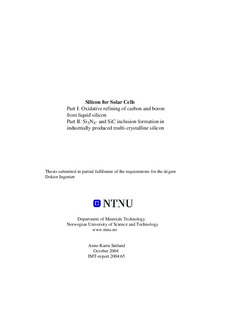| dc.description.abstract | This thesis work consists of two parts, each with a different motivation. Part II is the main part and was partly conducted in industry, at ScanWafer ASA’s plant no.2 in Glomfjord.
The large growth in the Photo Voltaic industry necessitates a dedicated feedstock for this industry, a socalled Solar Grade (SoG) feedstock, since the currently used feedstock rejects from the electronic industry can not cover the demand. Part I of this work was motivated by this urge for a SoG- feedstock. It was a cooperation with the Sintef Materials and Chemistry group, where the aim was to study the kinetics of the removal reactions for dissolved carbon and boron in a silicon melt by oxidative gas treatment. The main focus was on carbon, since boron may be removed by other means. A plasma arc was employed in combination with inductive heating. The project was, however, closed after only two experiments. The main observations from these two experiments were a significant boron removal, and the formation of a silica layer on the melt surface when the oxygen content in the gas was increased from 2 to 4 vol%. This silica layer inhibited further reactions.
Multi-crystalline (mc) silicon produced by directional solidification constitutes a large part of the solar cell market today. Other techniques are emerging/developing and to keep its position in the market it is important to stay competitive. Therefore increasing the knowledge on the material produced is necessary. Gaining knowledge also on phenomenas occurring during the crystallisation process can give a better process control.
Part II of this work was motivated by the industry reporting high inclusion contents in certain areas of the material. The aim of the work was to increase the knowledge of inclusion formation in this system. The experimental work was divided into three different parts;
1) Inclusion study
2) Extraction of melt samples during crystallisation, these were to be analysed for carbon- and nitrogen. Giving thus information of the contents in the liquid phase during soldification.
3) Fourier Transform Infrared Spectroscopy (FTIR)-measurements of the substitutional carbon contents in wafers taken from similar height positions as the melt samples. Giving thus information of the dissolved carbon content in the solid phase.
The inclusion study showed that the large inclusions found in this material are β-SiC and β-Si3N4. They appear in particularly high quantities in the top-cuts. The nitrides grow into larger networks, while the carbide particles tend to grow on the nitrides. The latter seem to act as nucleating centers for carbide precipitation. The main part of inclusions in the topcuts lie in the size range from 100- 1000 µm in diameter when measured by the Coulter laser diffraction method.
A method for sampling of the melt during crystallisation under reduced pressure was developed, giving thus the possibility of indicating the bulk concentration in the melt of carbon and nitrogen. The initial carbon concentration was measured to ~30 and 40 ppm mass when recycled material was employed in the charge and ~ 20 ppm mass when no recycled material was added. Since the melt temperature at this initial stage is ~1500 °C these carbon levels are below the solubility limit. The carbon profiles increase with increasing fraction solidified. For two profiles there is a tendency of decreasing contents at high fraction solidified.
For nitrogen the initial contents were 10, 12 and 44 ppm mass. The nitrogen contents tend to decrease with increasing fraction solidified. The surface temperature also decreases with increasing fraction solidified. Indicating that the melt is saturated with nitrogen already at the initial stage. The proposed mechanism of formation is by dissolution of coating particles, giving a saturated melt, where β-Si3N4 precipitates when cooling. Supporting this mechanism are the findings of smaller nitride particles at low fraction solidified, that the precipitated phase are β-particles, and the decreasing nitrogen contents with increasing fraction solidified.
The carbon profile for the solid phase goes through a maximum value appearing at a fraction solidified from 0.4 to 0.7. The profiles flatten out after the peak and attains a value of ~ 8 ppma. This drop in carbon content is associated with a precipitation of silicon carbide. It is suggested that the precipitation of silicon carbide occurs after a build-up of carbon in the solute boundary layer.
FTIR-measurements for substitutional carbon and interstitial oxygen were initiated at the institute as a part of the work. A round robin test was conducted, with the Energy Research Centre of the Netherlands (ECN) and the University of Milano-Bicocci (UniMiB) as the participants. The measurements were controlled against Secondary Ion Mass Spectrometer analyses. For oxygen the results showed a good correspondence between the FTIR-measurements and the SIMS. For carbon the SIMS-measurements were significantly lower than the FTIR-measurements. This is probably due to the low resistivity of the samples (~1 Ω cm), giving free carrier absorption and an overestimation of the carbon content. | nb_NO |
